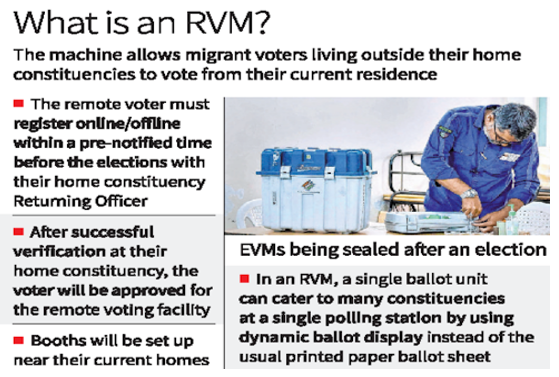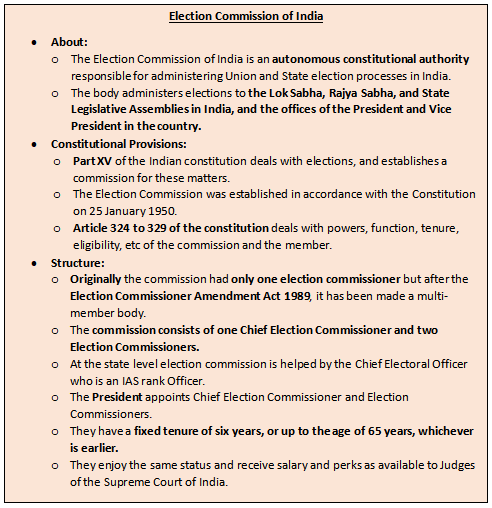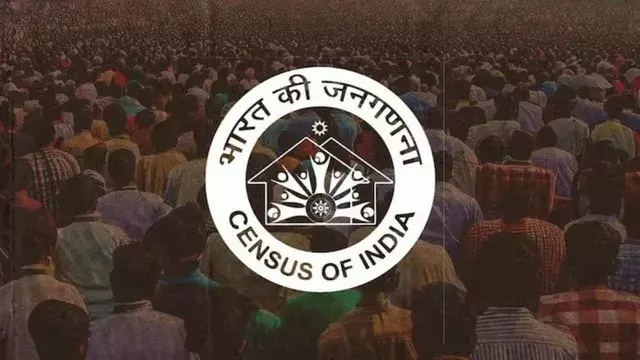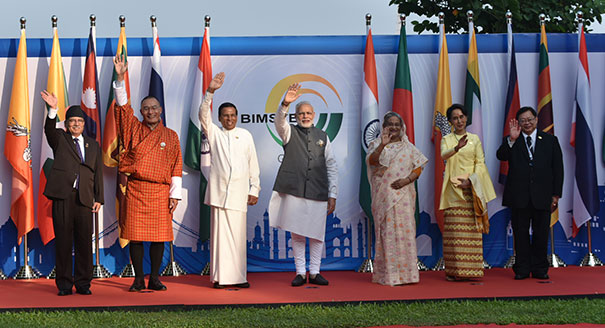- Courses
- GS Full Course 1 Year
- GS Full Course 2 Year
- GS Full Course 3 Year
- GS Full Course Till Selection
- Answer Alpha: Mains 2025 Mentorship
- MEP (Mains Enrichment Programme) Data, Facts
- Essay Target – 150+ Marks
- Online Program
- GS Recorded Course
- Polity
- Geography
- Economy
- Ancient, Medieval and Art & Culture AMAC
- Modern India, Post Independence & World History
- Environment
- Governance
- Science & Technology
- International Relations and Internal Security
- Disaster Management
- Ethics
- NCERT Current Affairs
- Indian Society and Social Issue
- NCERT- Science and Technology
- NCERT - Geography
- NCERT - Ancient History
- NCERT- World History
- NCERT Modern History
- CSAT
- 5 LAYERED ARJUNA Mentorship
- Public Administration Optional
- ABOUT US
- OUR TOPPERS
- TEST SERIES
- FREE STUDY MATERIAL
- VIDEOS
- CONTACT US
Remote Electronic Voting Machine (R-EVM)
Remote Electronic Voting Machine (R-EVM)
14-10-2023

Context
In late 2022, the Election Commission of India (ECI) proposed a Remote EVM (R-EVM) to address issues related to domestic migrant voting.
What is Remote EVM (R-EVM)?
-
About:
- The term "R-EVM" stands for "Remote Electronic Voting Machine." It is a proposed system by the Election Commission of India (ECI) aimed at facilitating voting for domestic migrants who are unable to vote in their home constituencies due to their current location away from their registered constituencies.
- In order to address the problem of domestic migrants voting, the R-EVM enables registered voters who have moved away from their home constituencies to cast their votes remotely.
-
Key Features:
- Registration Process: In order to use the remote voting feature, voters must register with the relevant Returning Officer (RO) in their home constituency—either online or offline—within a predetermined window of time.
- Remote Polling Station: The voter's current residence will be the location of a multi-constituency remote polling station, which will enable remote voting from that place.
- Handling Multiple Constituencies: Voters from several constituencies can efficiently cast their ballots at the same spot thanks to the RVM's capacity to handle up to 72 constituencies from a single remote polling station.
- Voting Process: The relevant constituency and candidate list will show up on the RVM display when the voter scans their constituency card in front of the presiding officer at the remote polling location.
- Instead of using a fixed paper ballot sheet, the RVMs employ electronic ballot screens to exhibit candidates and their symbols. They also share the same voting experience and security system as the current EVMs.
- On the RVM display, voters can choose the candidate of their choice. Every candidate in a constituency will have their votes counted and stored by the system.
- Countries Practice Remote Voting: Some countries such as France, Panama, Pakistan, Estonia Armenia etc, which practice remote voting for the citizens living abroad or away from their respective constituencies.
How Important Is the Vote of Migrants?
-
Migration Patterns and Reasons:
- Migrants in Delhi primarily come from neighbouring states such as Bihar, Uttar Pradesh, West Bengal, and Rajasthan.
- Employment opportunities are the primary cause for relocation (58%), followed by family-related reasons (18%) and relocation due to marriage (13%).
-
Migrant Demographics and Residence Duration:
- There appears to be a notable proportion of long-term migrants in Delhi since the majority of migrants (61%) have been there for more than five years.
- But many temporary migrants travel to Delhi for seasonal employment, particularly from Bihar.
- Voter Registration and Electoral Participation: While 27% of migrants are registered to vote in their home states, almost 53% of migrants have registered to vote in Delhi. Compared to local or panchayat elections, migrant participation in national and state-level elections is higher.
-
Return to Home States for Voting:
- Voting again, especially in local and state assembly elections, allows migrants—especially those from Bihar and Uttar Pradesh—to stay connected to their home states.
- Voters are returning to the polls for two reasons: first, to exercise their fundamental right to vote (40%) and second, to take advantage of the election season to visit relatives (25%).
-
Trust in Remote Voting System:
- Of the respondents, 47% have a tendency to trust the planned remote voting mechanism, whilst 31% have misgivings.
- There is a significant gender gap, with males (50%) displaying higher levels of trust than women (40%). Those with more education tend to have greater trust in the system.
Concerns and Challenges Ahead
- Similar Challenges with the EVMs: The voting process and security system of the Multi-Constituency RVM for Migrant Voting will be identical to those of the EVM. This basically indicates that when it comes to the RVMs, the issues with the current EVMs will still exist.
-
Amendments to Electoral Laws:
- In order to allow for remote voting, it is necessary to amend several existing laws, including The Representation of People's Act of 1950 and 1951, The Conduct of Election Rules, of 1961, and The Registration of Electors Rules, of 1960.
- The definition of "migrant voter" and whether they are still able to register at their original address must be clarified by the legal framework.
-
Voter Portability and Residency:
- Managing voter portability while adhering to the legal definitions of "temporary absence" and "ordinary residence" is a social challenge.
- Furthermore, the definition of remoteness—that is, an outside constituency, outside district, or outside state—as well as the geographical constituency idea of remote voting will need to be addressed.
-
Secrecy of Voting and Administrative Challenges:
- It can be difficult to ensure voting confidentially in remote areas, even if it's crucial to the process's integrity and confidentiality.
- An accurate voter identification system and measures to deter impersonation are essential components of a secure and equitable remote voting system.
- Arranging for polling agents and efficiently managing remote voting locations provide administrative and logistical difficulties.
-
Technological Challenges:
- In order to avoid voter confusion and mistakes, it is crucial to make sure that voters are conversant with the technologies and interfaces utilized for remote voting.
- Developing effective procedures for reliably tallying votes cast via remote voting represents a technological obstacle that needs to be overcome.
Way Forward
- Machine-Independent: The voting procedure must be machine-independent, or software and hardware-independent, in order to be verifiable and accurate. This means that determining its validity cannot be predicated just on the assumption that the EVM is accurate.
- Right to Cancel if Not Satisfied: "If a voter is dissatisfied, they should have complete authority to cancel a vote; the cancellation process should be straightforward and shouldn't involve the voter interacting with anyone."
- Confidence and Acceptability: It is critical to consider the trust and acceptability of all parties involved in the electoral process, including voters, political parties, and election administration.




